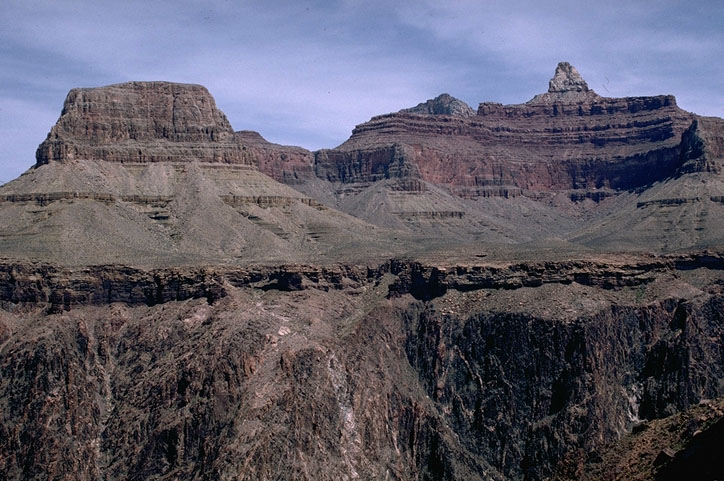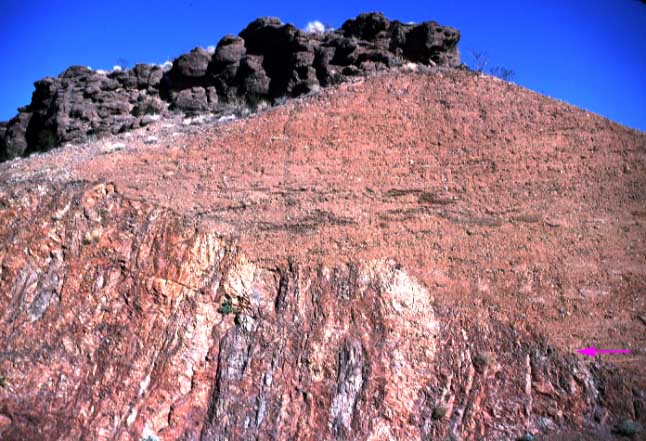An Unconformity Is A Buried
An unconformity are contact between two rock units. Unconformities are typically cached erosional surfaces that can represent a break in the geologic record of hundreds of millions of years or more. It called an unconformity because the ages of the layers of stone that are abutting each other are discontinuous. An expected age of layer or layers of rock is/are missing due to the erosion; and, some period in geologic time is not represented.

Disconformity
Disconformities are normally erosional contacts that are parallel to the bedding planes of the upper and lower rock units. Since disconformities are difficult to recognize in a layered sedimentary rock sequence, they are often discovered when the fossils in the upper and lower rock units are studied. A gap in the fossil record indicates a gap in the depositional record, and the length of fourth dimension the disconformity represents can exist calculated. Disconformities are ordinarily a result of erosion but tin can occasionally correspond periods of nondeposition.
Nonconformity
Anonconformity is the contact that separates a younger sedimentary rock unit from an igneous intrusive rock or metamorphic stone unit. A nonconformity suggests that a period of long‐term uplift, weathering, and erosion occurred to expose the older, deeper rock at the surface before information technology was finally buried by the younger rocks above it. A nonconformity is the quondam erosional surface on the underlying rock.

Athwart Unconformity
Anangular unconformity is the contact that separates a younger, gently dipping rock unit from older underlying rocks that are tilted or plain-featured layered rock. The contact is more obvious than a disconformity because the rock units are not parallel and at first appear cantankerous‐cutting. Angular unconformities generally represent a longer time hiatus than practise disconformities considering the underlying rock had ordinarily been metamorphosed, uplifted, and eroded earlier the upper rock unit was deposited.
Buttress Unconformity
A buttress unconformity (also chosen onlap unconformity) occurs where beds of the younger sequence were deposited in a region of pregnant predepositional topography. Imagine a shallow sea in which there are islands composed of older boulder. When sedimentation occurs in this ocean, the new horizontal layers of strata finish at the margins of the island. Eventually, as the bounding main rises, the islands are buried past sediment. But along the margins of the island, the sedimentary layers announced to be truncated by the unconformities. Rocks below the unconformities may or may not parallel the unconformities, depending on the pre-unconformity structure. Notation that a buttress unconformity differs from an athwart unconformity in that the younger layers are truncated at the unconformities surface

Unconformities Class
Nonconformities are due to relative changes in sea level over fourth dimension. Wave wear corrodes the materials exposed on the coastline and smoothes surfaces. At thousands to million years of scale, the coastline tin can motion in all regions. Removes materials exposed to erosion, wave and current. New (younger) materials may be deposited on the engraved surface.Shallow seas may alluvion in and and then withdrawal repeatedly.Long-lasting transgressions can erode away entire mountain ranges with enough time.
A transition occurs when a coastline migrates towards land as the sea level (or lake level) rises.
A regression occurs when a coastline migrates towards the sea when the declension falls to sea level (or lake level).
Ocean-level changes may result from regional uplifts or global sea-level changes, such equally the formation or melting of continental glaciers. Regardless of the reason for the change of sea level, when the ocean level falls, sediments erode from exposed soils. When the sea level rises, sediments are typically deposited in shallow continental shelves or littoral plains, such as in depression, swampy areas, in placidity water environments.
An Unconformity Is A Buried,
Source: https://geologyscience.com/geology/unconformities/
Posted by: estradahund1935.blogspot.com


0 Response to "An Unconformity Is A Buried"
Post a Comment